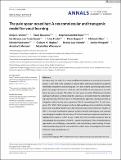Files in this item
The pale spear-nosed bat : a neuromolecular and transgenic model for vocal learning
Item metadata
| dc.contributor.author | Vernes, Sonja | |
| dc.contributor.author | Devanna, Paolo | |
| dc.contributor.author | Hoerpel, Stephen | |
| dc.contributor.author | van Tussenbroek, Ine Alvarez | |
| dc.contributor.author | Firzlaff, Uwe | |
| dc.contributor.author | Hagoort, Peter | |
| dc.contributor.author | Hiller, Michael | |
| dc.contributor.author | Hoeksema, Nienke | |
| dc.contributor.author | Hughes, Graham M. | |
| dc.contributor.author | Lavrichenko, Ksenia | |
| dc.contributor.author | Mengede, Janine | |
| dc.contributor.author | Morales, Ariadna | |
| dc.contributor.author | Wiesmann, Maximilian | |
| dc.date.accessioned | 2022-09-07T11:30:16Z | |
| dc.date.available | 2022-09-07T11:30:16Z | |
| dc.date.issued | 2022-11 | |
| dc.identifier | 280779087 | |
| dc.identifier | 92054ed7-520d-4cdf-b563-521411a29a1c | |
| dc.identifier | 000850532200001 | |
| dc.identifier | 85142268259 | |
| dc.identifier.citation | Vernes , S , Devanna , P , Hoerpel , S , van Tussenbroek , I A , Firzlaff , U , Hagoort , P , Hiller , M , Hoeksema , N , Hughes , G M , Lavrichenko , K , Mengede , J , Morales , A & Wiesmann , M 2022 , ' The pale spear-nosed bat : a neuromolecular and transgenic model for vocal learning ' , Annals of the New York Academy of Sciences , vol. 1517 , no. 1 , pp. 125-142 . https://doi.org/10.1111/nyas.14884 | en |
| dc.identifier.issn | 0077-8923 | |
| dc.identifier.other | ORCID: /0000-0003-0305-4584/work/118799948 | |
| dc.identifier.uri | https://hdl.handle.net/10023/25962 | |
| dc.description | Funding: UK Research and Innovation (Grant Number(s): MR/T021985/1; Grant recipient(s): Sonja Vernes). Max-Planck-Gesellschaft (Grant Number(s): Max Planck Research Group ; Grant recipient(s): Sonja Vernes). Human Frontier Science Program (Grant Number(s): RGP0058/2016, RGP0058/2016; Grant recipient(s): Uwe Firzlaff, Sonja Vernes). | en |
| dc.description.abstract | Vocal learning, the ability to produce modified vocalizations via learning from acoustic signals, is a key trait in the evolution of speech. While extensively studied in songbirds, mammalian models for vocal learning are rare. Bats present a promising study system given their gregarious natures, small size, and the ability of some species to be maintained in captive colonies. We utilize the pale spear-nosed bat (Phyllostomus discolor) and report advances in establishing this species as a tractable model for understanding vocal learning. We have taken an interdisciplinary approach, aiming to provide an integrated understanding across genomics (Part I), neurobiology (Part II), and transgenics (Part III). In Part I, we generated new, high-quality genome annotations of coding genes and noncoding microRNAs to facilitate functional and evolutionary studies. In Part II, we traced connections between auditory-related brain regions and reported neuroimaging to explore the structure of the brain and gene expression patterns to highlight brain regions. In Part III, we created the first successful transgenic bats by manipulating the expression of FoxP2, a speech-related gene. These interdisciplinary approaches are facilitating a mechanistic and evolutionary understanding of mammalian vocal learning and can also contribute to other areas of investigation that utilize P. discolor or bats as study species. | |
| dc.format.extent | 18 | |
| dc.format.extent | 3599418 | |
| dc.language.iso | eng | |
| dc.relation.ispartof | Annals of the New York Academy of Sciences | en |
| dc.subject | Bats | en |
| dc.subject | Genome | en |
| dc.subject | Language | en |
| dc.subject | MRI | en |
| dc.subject | Phyllostomus discolor | en |
| dc.subject | Speech | en |
| dc.subject | Tracing | en |
| dc.subject | Vocal production learning | en |
| dc.subject | QH301 Biology | en |
| dc.subject | QL Zoology | en |
| dc.subject | NDAS | en |
| dc.subject.lcc | QH301 | en |
| dc.subject.lcc | QL | en |
| dc.title | The pale spear-nosed bat : a neuromolecular and transgenic model for vocal learning | en |
| dc.type | Journal article | en |
| dc.contributor.sponsor | UK Research and Innovation | en |
| dc.contributor.institution | University of St Andrews. St Andrews Bioinformatics Unit | en |
| dc.contributor.institution | University of St Andrews. Institute of Behavioural and Neural Sciences | en |
| dc.contributor.institution | University of St Andrews. School of Biology | en |
| dc.identifier.doi | https://doi.org/10.1111/nyas.14884 | |
| dc.description.status | Peer reviewed | en |
| dc.identifier.grantnumber | MR/T021985/1 | en |
This item appears in the following Collection(s)
Items in the St Andrews Research Repository are protected by copyright, with all rights reserved, unless otherwise indicated.

